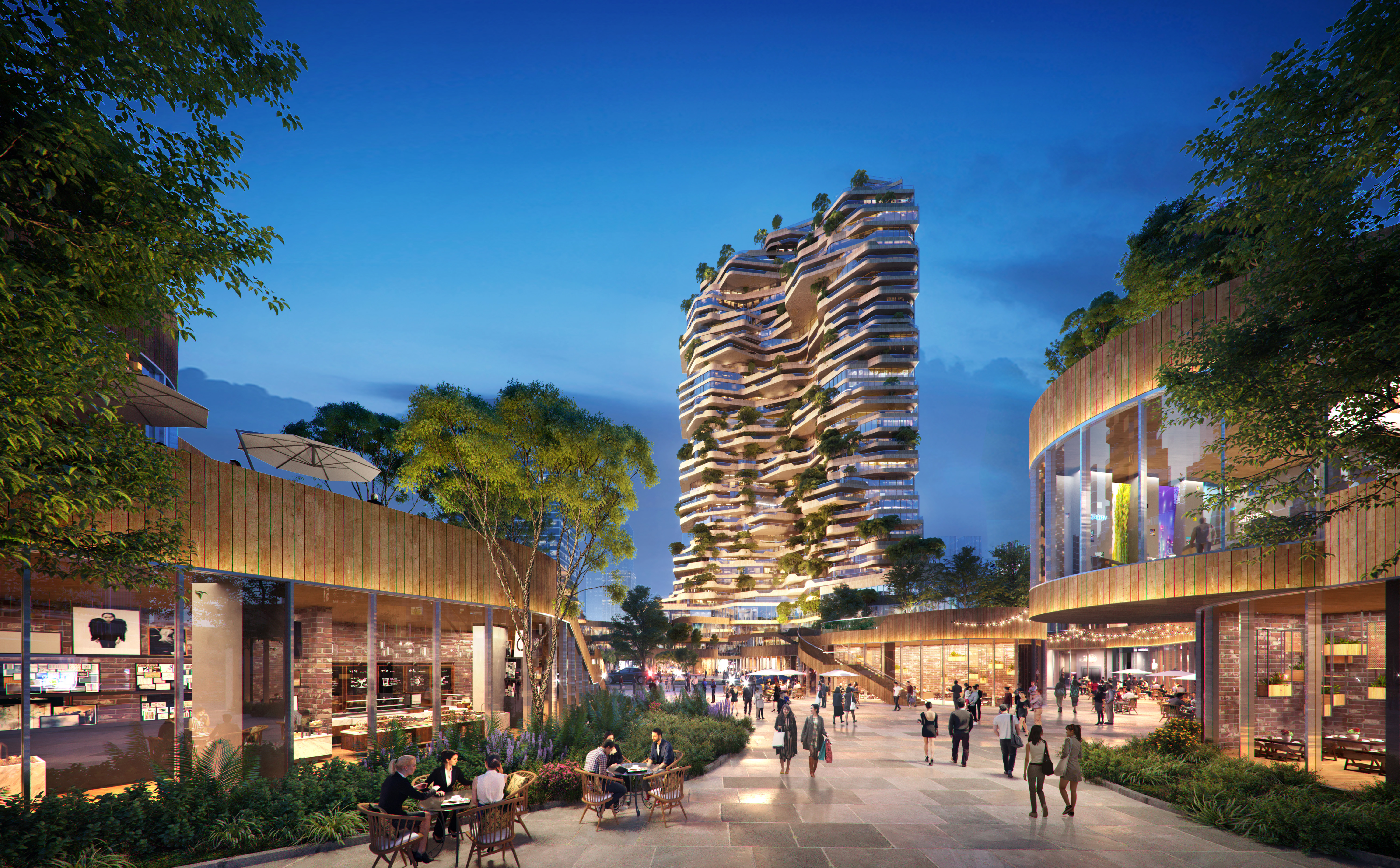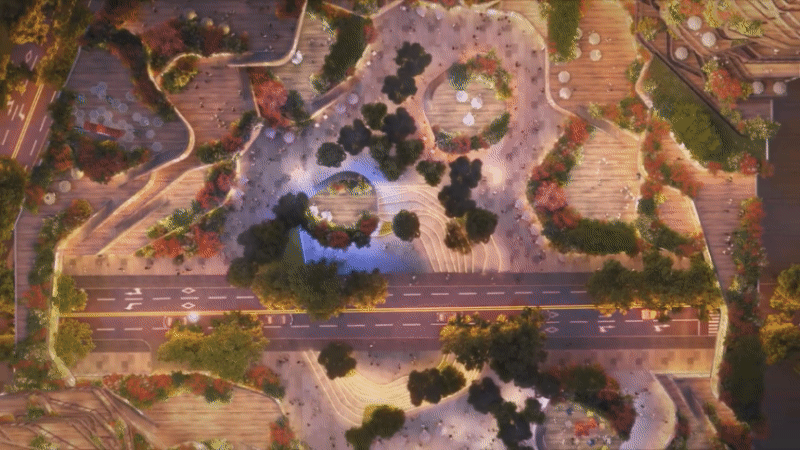
设计单位 MVRDV
项目地点 江苏南京
方案状态 中标方案
建筑面积 16.6万平方米
南京,作为中国东部的中心城市之一,正在迅速发展。为了满足经济增长的要求,2015年,当地政府提出了江北新区的规划,拟将南京城区向西扩展到长江对岸。
The Chinese metropolis of Nanjing is growing rapidly. To enable this growth, in 2015 the government formed the Jiangbei New Area, expanding Nanjing to the west across the Yangtze River.
同年,在江北新区金融中心二期商住综合体(18-34、18-35地块)的设计竞赛中,MVRDV携“绿洲大厦”的方案中标,方案勾勒了两座高150米的塔楼和其间如绿洲般茂盛的景观,将为高密度城市中的居民提供绿意盎然的栖居“天堂”。
MVRDV has now won a competition to design a mixed-use residential and commercial complex on the edge of the Jiangbei New Area’s Financial District. With a green landscape nestled between two 150-metre-tall towers, Oasis Towers will provide a haven for residents in a dense and rapidly developing part of the city.

▲ 动画视频 ©Atchain
项目横跨江北金融区计划范围边界上的两个毗邻的街区。两座40层高的L形塔楼各据一角,南北相望。三至四层高的裙楼包裹并串联起整片基地,在中心区域形成保护性的环境。裙楼将两个地块之间的人行通道和街道连接起来,强调了两个地块的整体性,并让“绿洲”大厦从高密度的城市环境中脱颖而出。
The project spans two adjacent blocks on the edge of the Jiangbei Financial District masterplan. The project’s two L-shaped towers, each 40 storeys in height, face each other from the north and south corners, while the podium of 3–4 storeys forms a perimeter that encloses almost the entire site to create the protective environment at its heart. This perimeter building bridges over pedestrian access routes and even the street between the two plots, creating a clear separation between the surrounding neighbourhood and the oasis at the centre of the design.



“绿洲”景观呈梯田的形态分布,包含了丰富的植被,为商业裙楼打造郁郁葱葱的购物环境。公园般的景观提供了多种功能:冷却城市热能、增加生物的多样性;天蓬在高层住户和低层商业的购物者之间形成遮挡,起到保护隐私的作用;同时,景观跨越了中央道路,将相隔的两个地块连通,形成步行友好的环境。在公共空间的中心位置,绿植向下延伸至地面道路,形成了一个便捷的交通枢纽,并连接起地下的地铁站。
Peppered with trees and other greenery, the oasis forms a green landscape on the building’s cascading terraces, a lush environment for shopping in the building’s commercial floors from ground level up to the third floor. This park-like space has a number of functions: it provides cooling and biodiversity, the canopy offers privacy by shielding the residents of the upper floors from the shoppers below, and it creates a walkable environment that connects the two plots across the central road. At the very centre of the public space, the landscape steps down below ground level to connect beneath the road, providing a convenient crossing point and allowing access to the metro station beneath the site.


事务所创始合伙人Winy Maas说道:“南京当代建筑的形式和外观往往从自然中汲取灵感。我们希望通过设计绿洲大厦,将这一手法运用到极致——不仅通过运用弯曲、层次分明的‘山崖’来致敬自然,同时通过引入绿植和它们的生长蔓延,将自然真正融入设计中。”
“The contemporary architecture of Nanjing takes its inspiration from nature in form and appearance”, says MVRDV founding partner Winy Maas. “With Oasis Towers we wanted to push this trend to the max – not only emulating nature with curving, stratified ‘cliffs’, but also to literally incorporate nature into the design with the greenery and by tapping into natural processes.”


为与项目四周环绕的摩天大楼相呼应,面向道路的外立面使用了相对正式的网格状肌理。向内的外墙则依循阳台、露台、屋顶和凉亭的形状产生流动的不规则曲线,其中凉亭部分的外墙运用了由再利用的竹子覆盖。
To respond to the office skyscrapers that will emerge in its surroundings, the design has a formal, gridded façade on the outer faces of the perimeter block. Elsewhere, this exterior skin gives way to the flowing curves of balconies, terraces, rooftops, and small pavilions clad in facades of recycled bamboo.

建筑师将自然融入设计的手法并不止于田园诗般的绿色景观,自然在可持续战略中发挥了重要作用。其中,有些无法进入的屋顶空间种植了丰富的植被,最大化“绿洲”的生物多样性。另外,屋顶上还设置了两片面积达500平方米的芦原,作为建筑灰水循环系统的一部分,可对生活污水进行自然过滤和清洁。
The integration of nature into the design goes even further than its idyllic green environment, with nature playing an important role in the design’s sustainability strategies. Rooftops in the oasis that are not accessible are densely planted with a variety of species that help to maximise biodiversity. Also included in these non-accessible roofs are two 500-square-metre reed beds that naturally filter and clean water as part of the building’s greywater recycling system.


利用南京西风盛行的气候条件,塔楼的布局最大限度地提高自然通风。错落分布的深阳台能够提供丰富的自然采光,同时减少夏季的阳光照射;精心设置的树木将在较热的月份提供额外的阴凉空间。通过水源热泵,建筑也能够利用邻近的河流来减少能源消耗。
The positioning of the towers takes advantage of the prevailing western winds to maximise natural ventilation. The deep balconies are staggered to provide plenty of natural light, while reducing solar gain in the summer, along with the carefully placed trees that provide extra shade in the warmer months. A water-source heat pump makes use of the adjacent river to reduce energy consumption.

塔楼的形态乍看之下千变万化,每层楼都与上下的邻居不同,但实际上,设计遵循了高效和规范的原则;塔楼楼层的大部分平面布局几乎是相同的,只有阳台的曲线形态有所不同。阳台上设置了盆栽,保护了相邻住户的私密性,将“绿洲”的自然之美延伸至建筑的最顶端。
The towers appear highly varied at a glance, with every floor differing in shape from its neighbours above and below, yet the design in fact is highly efficient and regularised; floor plans for large sections of the towers are almost identical, with only variations in the shapes of the curving balconies. Planters separate neighbouring balconies, ensuring that the green oasis extends to the very top of the design.

“绿洲”大厦的业主为南京江北新区中央商务区投资发展有限公司,目前,MVRDV正与业主团队进行方案的深化设计。
MVRDV designed Oasis Towers for Nanjing Jiangbei New District Financial Center Development Co. Oasis Towers will occupy the neighbouring plots 18-34 and 18-35 in the Jiangbei Financial District Masterplan. MVRDV is now working with the client in the design development phase.

设计图纸 ▽




完整项目信息
Project Name: Oasis Towers
Location: Nanjing, China
Year: 2021–
Client: Nanjing Jiangbei New District Financial Center Development Co, Ltd
Size and Programme: 166,000m2 mixed-use (residential and retail)
Architect: MVRDV
Founding Partner in charge: Winy Maas
Partner: Wenchian Shi
Design Team: Kyo Suk Lee, Sredej Bunnag, Shanshan Wu, Daehee Suk, Americo Iannozzone, Haochen Yang, Echo Zhai, Albert Parfonov, Jiani You, Evan O'Sullivan
Environmental Advisors: Peter Mensinga, Arjen Ketting
Copyright: MVRDV Winy Maas, Jacob van Rijs, Nathalie de Vries
Structural engineering & MEP: TJAD
Visualisations: ©Atchain
版权声明:本文由MVRDV授权发布。欢迎转发,禁止以有方编辑版本转载。
投稿邮箱:media@archiposition.com
上一篇:25个正在消失的建筑与文化遗产:2022年世界古迹守护名单公布
下一篇:成都邛窑遗址公园的“新遗址”:建筑与艺术创新实验室 / 合造社CLAB